8 Warning Signs Your Tongue May Be Sending About Your Health
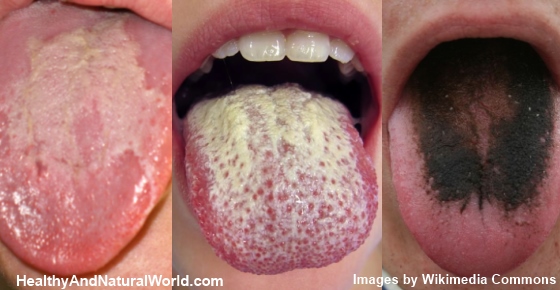
As a child, I was taught not to stick out my tongue but it turns out that the tongue can be an extremely important gauge of overall health. From vitamin deficiencies to more serious health threats, the truth is often written on your tongue.
Your tongue can actually be a valuable tool that you can use to keep track of your health. Here are some tips on how to understand what your tongue is telling you.
The Main Focus Areas of Your Tongue
There are three main focus areas that you need to check when you examine your tongue:
- The first is tongue color. The color of your tongue can tell you a lot about your circulatory system and it may also tell you about levels of oxygen in your body.
- The second area that is important is the coating. Tongue coating can give you an indication of how well your digestive system is working.
- Finally, the tongue tip and sides of the tongue are also important tools for self-diagnosis.
Here are some of the more common things you may see on your tongue and what they mean:
1. White Patches
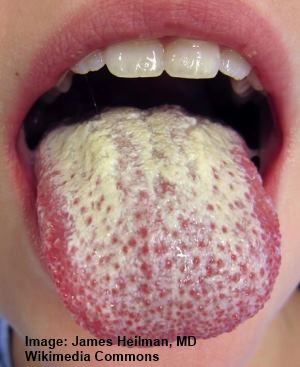 A white coating on your tongue could mean that you have a yeast overgrowth.[1] But before you panic about yeast infections like candida, try brushing your tongue properly for a week and then see if the white patches or coating persist.
A white coating on your tongue could mean that you have a yeast overgrowth.[1] But before you panic about yeast infections like candida, try brushing your tongue properly for a week and then see if the white patches or coating persist.
Candida overgrowths often occur when you have been ill and have used antibiotics, or when your immune system is run down. Balancing your gastrointestinal environment with healthy levels of probiotics from fermented foods, good quality natural yoghurt, or a probiotic supplement can be a great way to restore gastrointestinal balance in the digestive tract. If the white patches persist, then see your physician as oral cancer can often start in these areas.
Further reading: Read about the top signs that you have candida infection and what to do about it.
2. A Webbed or Striped Look
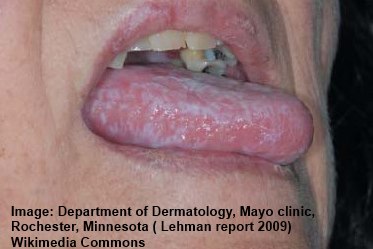 This may be an indication of s chronic inflammatory autoimmune disease which is called Oral Lichen Planus. If you don’t have pain, then your doctor may not treat the condition, but immune function plays a vital role in supporting your health, and ignoring immune system malfunction can be dangerous.
This may be an indication of s chronic inflammatory autoimmune disease which is called Oral Lichen Planus. If you don’t have pain, then your doctor may not treat the condition, but immune function plays a vital role in supporting your health, and ignoring immune system malfunction can be dangerous.
Turmeric has been used for thousands of years to regulate and support the immune system. In a study published in the Natural Journal of Maxillofacial Surgery, researchers successfully used turmeric to treat Oral Lichen Planus.[2] Turmeric is one of the 13 powerful antibiotics that don’t require a prescription, but due to its low absorption and rapid metabolism you need to optimize turmeric absorption. You can also add turmeric to your diet by trying this golden milk recipe.
3. Ridges or Indentations
When you examine your tongue, you may find a ridge running down the center of your tongue or ridges radiating out from the center. You may also find ridges along the edge area. Ridges are generally a natural part of the tongue and you don’t need to be overly concerned about them.
Just make sure you brush your tongue properly if the ridges are deep to eliminate any food that may be trapped in that area.
4. Red Tongue
A healthy tongue is a rosy pink color. If you notice your tongue has become red, then you may need to pay attention and take action where necessary.
Strep throat is often found in conjunction with a red tongue. Scarlet fever also causes a red tongue. If you have a red tongue and sore throat or some sort of infection, then chances are that it is related to your infection and your doctor will treat you accordingly.
A red tongue can also be an indication of vitamin deficiencies, particularly deficiencies in vitamin B12, folic acid, or iron.[3] If the red tongue persists, then you should ensure your vitamin intake meets your body’s needs. You can get familiar with the symptoms of vitamin B12 deficiency and iron deficiency.
5. Bumps
Tongue bumps can be an indication of various conditions. Bumps can be caused by physical trauma like biting your tongue. If that is the case, then you need not worry and your tongue will most likely heal naturally.
If you have mouth ulcers, then it may be an indication of stress, but you will do well to keep an eye on bumps. If the bumps are painful or if they do not go away naturally, then bumps could be an indication of oral cancer and you should see your physician to investigate.
Sore or swollen bumps on your tongue can also result from inflamed taste buds, called transient lingual papillitis (TLP). There are different conditions than can irritate the small taste buds that cover the top and sides of your tongue resulting in inflammation, and you can read about them in my article on how to get rid of swollen taste buds.
Another type of sore that can affect the area under your tongue and be a source of pain is a canker sore. Canker sores look like small white ulcers in the mouth and can be very painful.
6. Black Hairy Tongue
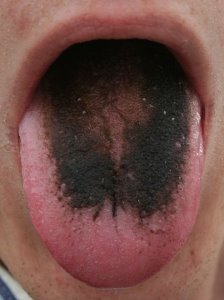 This is possibly the most alarming sign you may see on your tongue in terms of what this looks like, but a black and hairy tongue is actually quite common and for the most part of no special concern.
This is possibly the most alarming sign you may see on your tongue in terms of what this looks like, but a black and hairy tongue is actually quite common and for the most part of no special concern.
The little “hairs” on your tongue are called papillae and they grow throughout your lifetime. In some cases they become quite long and they may offer a safe place for bacteria that cause the black spots on tongue.
This look may be a result of poor oral hygiene, recent antibiotic use, or a fungal infection and can result in bad breath. An antibacterial mouth wash may be useful, or simply brushing the tongue with a soft toothbrush and toothpaste 2-3 times a day should help, but for the most part a black and hairy tongue is not an indication of serious underlying conditions.
7. Spots
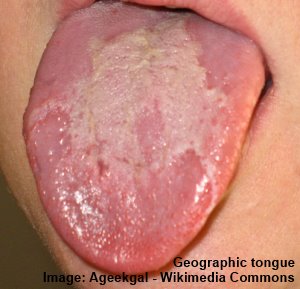 Certain spots on the tongue may also have some messages for you in terms of oral health.
Certain spots on the tongue may also have some messages for you in terms of oral health.
If you have on your tongue a mixture of red and white spots which sometimes looks like continents on a world map, then you have what is called geographic tongue. This condition is harmless.
If your tongue has spots that look similar to cottage cheese then you may have oral thrush and this may be an indication of a weakened immune system.
White patches that grow could be an indication of Leukoplakia which more commonly occurs in those who smoke or chronically drink alcohol. Although Leukoplakia is not inherently dangerous, you need to get your dentist to check it at your next visit as it can be a precursor to cancer.
If the spots become sensitive or sore, or if ulcers persist, then it is best to get your physician to rule out disorders like oral cancer.
8. Macroglossia
An enlarged tongue is often called Macroglossia. There are several reasons for this condition, such as genetic disorders, but an enlarged, sometimes protruding tongue, particularly in children, may be a sign of hypothyroidism. Hypothyroidism occurs when the thyroid is under-active.
If you have noticed your child’s tongue is larger than normal, then you need to consult your physician.
Never Ignore Your Body
The above symptoms are only some of the indications you may see by examining your tongue. The most important tool for supporting health is your body. Learn to pay attention to your body and listen when it talks to you.
Read these related articles:
- Bumps on Tongue: Causes and Natural Treatments
- 11 Health Warnings Your Fingernails May Be Sending
- 10 Health Warnings Your Eyes May Be Sending And How To Protect Your Eyes
- Warning Signs of Heart Disease Can Be Detected In Your Eyes
